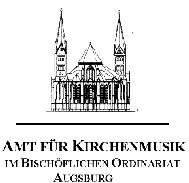Office for church music, Peutinger street 5,
86152 Augsburg
Cath. parish office "St. Martin" Batzenhofen
Martin street 6
86368 Gersthofen

Telephone (0821) 3166-851
fax (0821) 3166-859
Augsburg, 20. June 2002
Cath. church foundation "St. Martin" Batzenhofen
here: Organ of the parish church
to the local meeting of 12.06.2002
Dear Reverend Mr. Priest Walser, very honored members of the church administration!
The disposition of the organ is as follows:
1st Manual:
C-f'''
Bourdon 16'
Principal 8'
Gedeckt 8'
Flute 8'
Salicional 8'
Octave 4'
2nd Manual:
C-f'''
(swellable)
Geigenprincipal 8'
Lieblich Gedeckt 8'
Salicional 8'
Aeoline 8'
Voxcoelestis 8'
Flute 4' build as Transverse flute
Quinte 2 2/3' (Inscription on the stop rocker 1 1/3')
Piccolo 2'
Pedal:
C-d'
Sub bass 16'
Stillgedeckt 16' wind swell
Violin bass 8'
Cello 8'
Normal couplers, Sub- and Super couplers II/I FP and release; p, mf, f, Tutti and release
A general overhaul of the existing organ work is to be advised against for several reasons:
1st Due to the confine design also after a general overhaul the instrument remains unfriendly to maintain which will result in further faulty behavior.
2nd Current large weaknesses of the instrument like e.g. the insufficient effect of the swelling flaps of the 2nd manual and the rather poor intonation will remain.
3rd For an adequate general overhaul the technical system of the console would have to be renewed completely. This is connected with very high costs, which highly question the expenditure for such an overhaul.
The recommendation is therefore a general technical and tonal new conception of the instrument, where the pipe material of the current organ, which has quite intonating reserves, the organ casing, the blower engine and the bellows can be reused.
For such a renewal of the work two concepts present themselves:
1st Build an organ with so called change loops for the manual wind chest, i.e. all stops are alternatively playable on the first or second manual.
Disposition proposal:
Manual:
C-g'''
Bourdon 16' old
Principal 8' (new casing pipes,
interior pipes possibly old)
Flute 8' (old)
Lieblich Gedeckt 8' (old)
Salicional 8' (old)
Vox coelestis 8' (old)
Octave 4' (old)
Flute 4' (old)
Quinte 2 2/3' (old)
Piccolo 2' (old)
Terz 1 3/5' (new)
Mixtur 2' (new)
Trumpet 8' (new)
Pedal
C-f'
Sub bass 16' (old)
Violin 8' (old)
attached console, mechanical play and stop actions, normal couples
2nd Build an instrument in the style of a smaller organ of the later French romantic. This concept is based on a relatively small number of stops but nevertheless very colorful in sound.
Disposition proposal: :
1st Manual:
C-f'''
Bourdon 16' (old)
Principal 8' (partly. new s. a.)
Flute 8' (old)
Gamba 8' (partly. old from Cello)
Octave 4' (old)
Mixtur 2 2/3' (partly. old from
Quint 2 2/3' and Piccolo 2'
from the current organ
complemented with according choirs)
2nd Manual:
C-f'''
(swell work
in new swell chest)
Lieblich Gedeckt 8' (old)
Salicional 8' (old)
Vox coelestis 8' (old)
Flute trav. 4' (old)
Tromp. harmonique 8' (new)
Oboe 8' (new)
Pedal
C-f'
Bourdon 16'(Transmission)
attached console, mechanical key actions, electrical stop actions, normal couples, Sub and Super couple II/II and II/I, cancel button (Appel) for Trompette harmonique 8' , Octave 4' and Mixture 2 2/3'.
With the organ construction you should assign a quality-conscious organ building shop, having the appropriate "know how" for the concepts mentioned above.
If you have further questions, I am gladly to your disposal.
Yours sincerely

P. Stefan U. Kling - official organ expert
Translated to the best of knowledge and belief by Franz X. Koehler